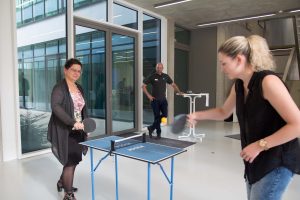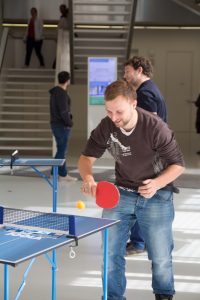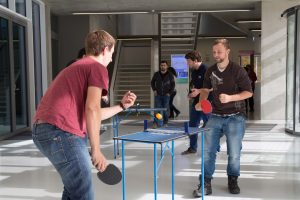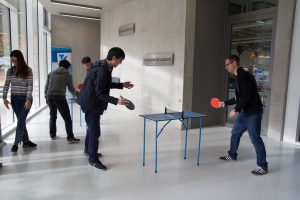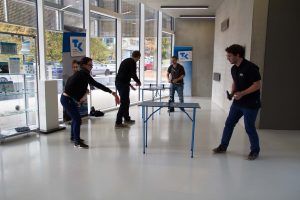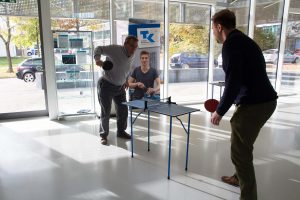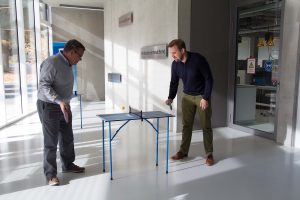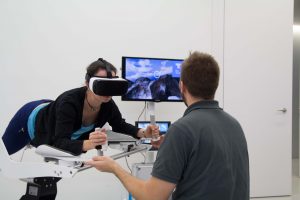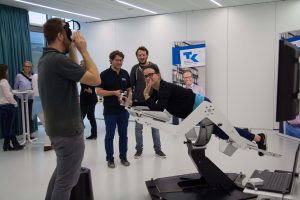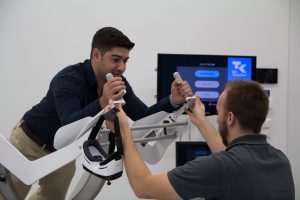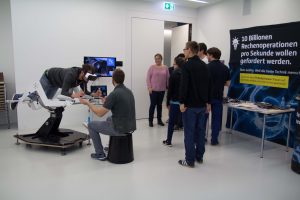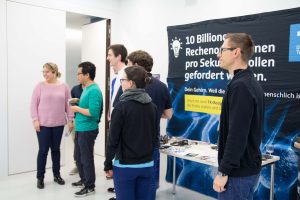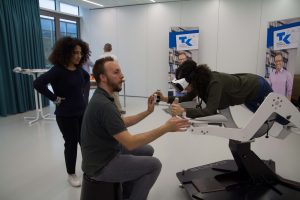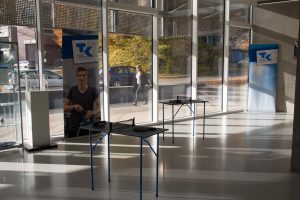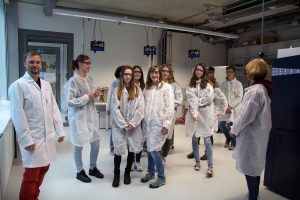
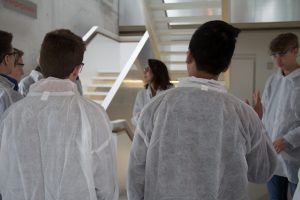

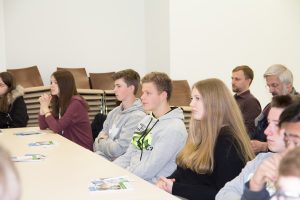
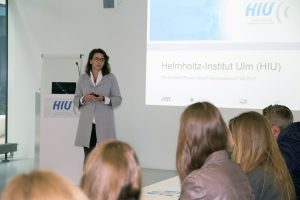
In the course of a two-day field excursion, pupils from the Robert-Bosch Secondary School Gerlingen visited the HIU on the 27th of April 2017. Following a presentation by managing director Dr. Dagmar Oertel, the visitors were given a guided tour through the laboratories by Dr. Oertel and scientist Tobias Braun.
The main purpose of the visit was to provide the pupils with an insight into research on batteries and to present possible career opportunities. The 20 students of 10th grade, who focus on natural sciences with their chosen subject NwT (natural sciences and engineering), showed interest in current research topics and alternative research focuses.





On 31.05.2017, Prof. Doris Wedlich and Dr. Christian Röthig came to the HIU during the annual visit of the divisional management. After a presentation of the activities of the HIU by the director Prof. Maximilian Fichtner and a subsequent discussion, three scientists from HIU presented their research areas and were available to answer questions: Dr. Franziska Klein informed about the research activity of the HIU regarding halide ion batteries. The research of Dr. Birger Horstmann deals with the use of zinc-air batteries with regard to novel electrolytes. Dr. Dominic Bresser, in turn, researches alternative anodes for lithium-ion batteries.
In a following round of questions, representatives of the directorate, the science and the administration also got into conversation. At the end of the meeting, the visit ended with a walk through the building and a guided tour of the labs.
Prof. Dr. Doris Wedlich has been Head of Division for the Division I since 2014. The Division I combines research, teaching and innovation in the scientific disciplines of biology, chemistry and process engineering. Dr. Christian Röthig, in turn, is responsible for the areas of human resources and resources.
Since the beginning of the year, there have been a further Young Investigator Group at HIU: Novel electrode materials for rechargeable electrochemical energy storage – in short: NEW E2. . It was officially acknowledged as KIT Young Investigator Group this month. In the next few years, the team around Dr. Dominic Bresser will focus on the research and development of innovative anode materials which store lithium ions reversibly through a combination of conversion and alloying reactions. The goal here is to enable higher energy and power densities.
The research project is funded by the Vector Foundation for the next three years.
http://www.hiu-batteries.de/battery-research-center-in-germany/news/spalte-1/news/dr-dominic-bresser-receives-funding-for-investigation-of-novel-electrode-materials/
In addition to Dominic Bresser, three doctoral students – Jakob Asenbauer, Tobias Eisenmann and Yanjiao Ma – will be researching the topic. The appointment of another doctoral student is scheduled for September.
The research work of NEW E2 responds to current developments in electromobility and the associated growing demand for advances in these storage technologies.
On 27 and 28 June, representatives of the Helmholtz Institutes of Ulm and Münster met at the HIU. The aim of the second-day meeting was to strengthen the future cooperation. A joint workshop, in which scientists from both institutes presented their research activities, offered all participants the opportunity to exchange ideas. The lectures covered a wide range of research and were therefore of great interest. This was shown in the following discussions.
The HI MS, like the HIU and currently seven other Helmholtz Institutes, belongs to the Helmholtz Association and is operated as an external center of the Forschungszentrum Jülich.

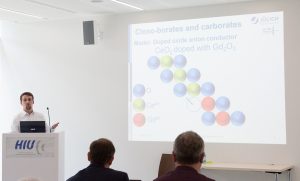
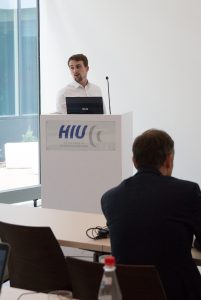
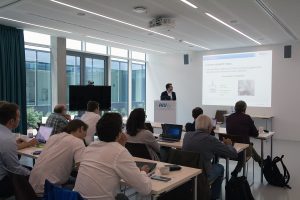
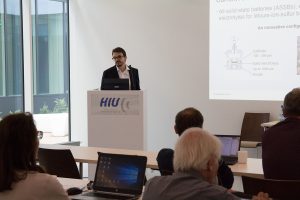
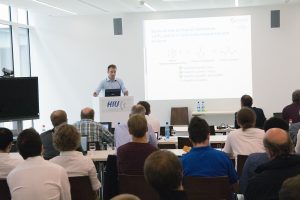
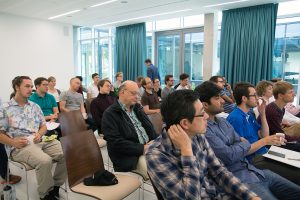
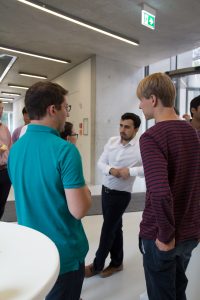
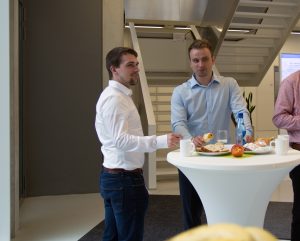
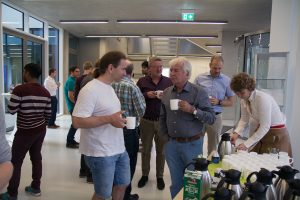
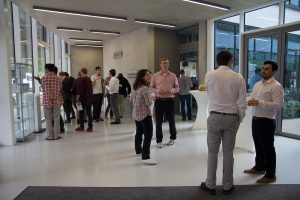
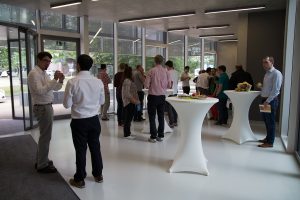

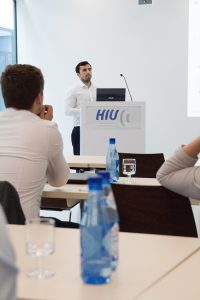
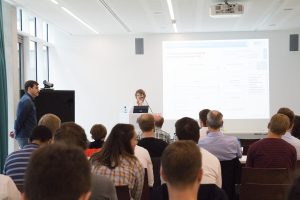
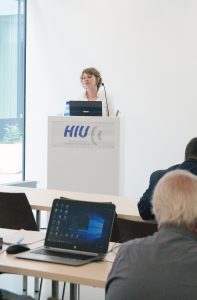
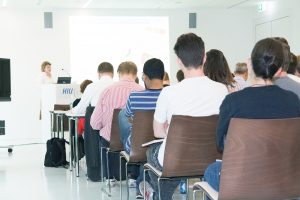
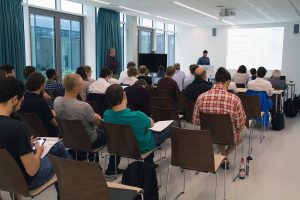
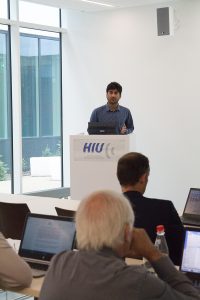
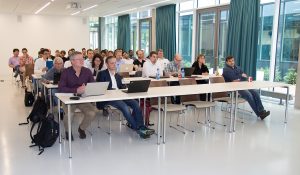
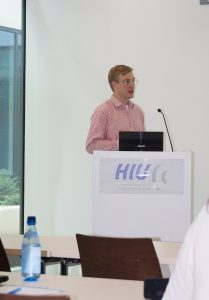
From the 25th to the 30th of June the 67th Lindau Nobel Laureate Meeting was held in Lindau, Germany. This year, it was dedicated to the field of chemistry. In the course of the annual events, 28 Nobel Laureates and over 400 young international scientists – students, doctoral and postdoctoral students – came into contact with each other in order to foster the scientific and cultural exchange between the different generations and disciplines.
Dr. Dominic Bresser represented the HIU during the boat trip across the Lake Constance, which traditionally concludes the meeting. Also in this year, there was a large number of young scientists showing great interest in the activities carried out at HIU, many of them also with a scientific background in the field of energy storage and conversion. Among the interested visitors were also Mr. Ulrich Steinbach, head of the Ministry of Science, Research and the Arts of the state of Baden-Württemberg, and Dr. Klaus Kleinfeld, formerly CEO of Siemens and Alcoa, who was appointed as Honorary Senator of the Lindau Foundation in the course of this event.
The boat trip to the Mainau Island, including a final panel discussion – this year about “Ethics in Science” – and a subsequent picnic is organized by the State of Baden-Württemberg and offers the participants and visitors a platform for further informal exchange prior to the official end of the meeting.
Since 1951, the Lindau Conferences have been organized as an international forum for international scientific exchange. Alternately, they are devoted to the natural scientific Nobel Prize disciplines physiology/medicine, physics and chemistry.


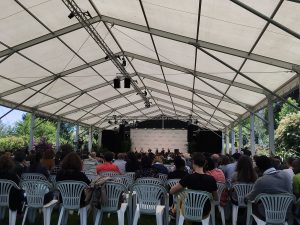
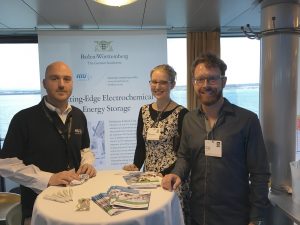
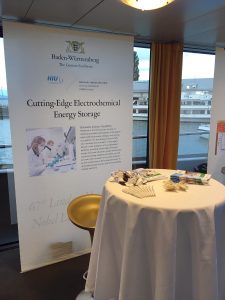

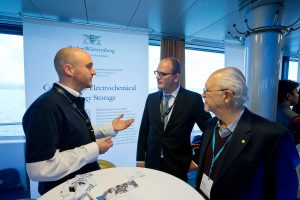
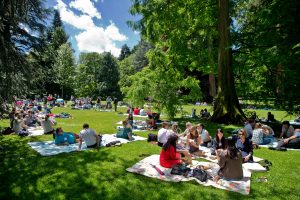
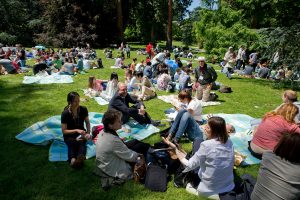

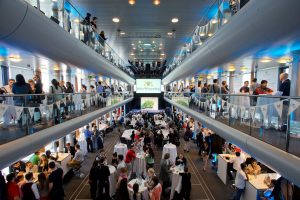
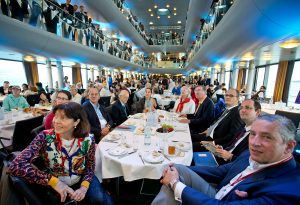
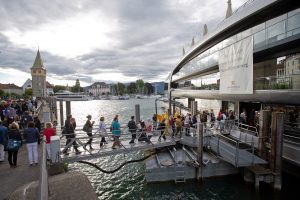
The “Long Night of Science” was a great success: on July 21st, up to 7,000 visitors found their way to the campus of the University South between 4pm and midnight. Many of them also visited the HIU.
From 4 to 9:30 pm the highly interested visitors of all age classes were able to gain an insight into the current battery research. The great interest was shown not only by the permanently well-filled lecture room, but especially by the multitude of questions following the respective lecture. The highly frequented guided tours through the building and selected laboratories allowed visitors to get an impression of the everyday life of the scientists.
Dr. Syed Atif Pervez has recently joined the Helmholtz Institute Ulm (HIU) as Guest Scientist from Pakistan. Within the framework of an Alexander von Humboldt fellowship, his research is located in the field of renewable energy storage.
During his PhD he worked at the Korea University of Science and Technology, South Korea on the following topic: Nanostructured Materials for Energy Storage Applications. Prior to joining HIU, Dr. Atif worked as Postdoctoral Researcher at the University of Calgary, Canada.
– Ulm, 04/09/2017 –
Why did you apply for Alexander von Humboldt (AvH) Research Fellowship?
Winning AvH fellowship is undoubtedly the greatest achievement in my professional career, something I am really proud of. AvH fellowship offers an excellent platform to scientists and scholars from abroad and Germany to work on research projects of mutual interest. This is also an excellent opportunity to build professional relationships with over 28,000 Humboldtians alumni in more than 130 countries — including 54 Nobel laureates.
And why did you choose the Helmholtz Institute Ulm (HIU)?
HIU is a research institute specifically working on Electrochemical Energy Storage, which is my area of work. So for me it was a natural decision to join the institute. In HIU, I expect to get opportunities for unparalleled training through extensive collaborations, access to world-class research facilities, and chances to work with commercial corporations.
What have you been researching so far and what are your research interests here at HIU?
Most of my research experience has been in the field secondary batteries. With growing energy demands for futuristic applications such as electric vehicles and smart grid energy storage, better and safer battery technologies must be developed.
My work in HIU is focused on developing all-solid-sate Li-ion batteries where the conventional organic liquid electrolyte is replaced with solid-state electrolyte. The practical application of conventional Li-ion battery is retarded by safety concerns due to irregular lithium deposition and growth of lithium dendrites, as well as the properties of volatility, flammability and easy leakage of the conventional organic liquid electrolytes. All-solid-state batteries that use solid-state electrolytes offer improved safety features such as avoiding flammability and liquid leaks.
What is the scope of your research work in your home country?
Due to enormous increase in energy demand, Pakistan in recent years has been severely affected by energy crisis and power shortages which has created a great deal of awareness on relying on renewable energy sources. Pakistan is enriched with various renewable energy sources such as hydel, solar, wind, bio gass etc. There is an estimated 100000 MW of hydro and wind energy potential. Similarly, the average solar radiation of 5.5 KW/m2 and 300 clear days makes the country with one of the highest insulations in the world. Furthermore, the solid wastes can generate up to 21.35 million M3 of bio-gas. All these figures indicate an enormous scope of work in the field of renewable energy.
Is the topic of your research relevant to the future development of your country?
For efficient energy harvesting, a stable and reliable storage system is of utmost importance. The work in my research outline aims at realizing a stable and highly efficient energy storage setup using innovative solid state batteries. Considering the current energy crisis in the country, the work forms close relevance to the future development of my country. Successful demonstration of an efficient and cost-effective storage setup will garner strong interest from government authorities, researchers and industries alike. This will draw attention from funding agencies and there will undoubtedly be great interest in grants supporting the further expansion of the research.
In the framework of the German „Excellence Strategy“ of the Federal Government and the States, a proposal about “Energy Storage Beyond Lithium“ has been successful in the first round.
The proposal is co-ordinated by researchers from Helmholtz-Institute Ulm (HIU) together with colleagues from Ulm University and Karlsruhe Institute of Technology (KIT) and comprises future activities in 25 working groups in Ulm, Karlsruhe and Gießen. Starting point and nucleus of the effort are the very successful activities at HIU on post-Li systems, which have gained high international visibility and recognition. If the second round of selection is also successful, the work can start in January 2019.
Prof. Dr. Anjan Sil from the Institute of Metallurgical and Materials Engineering at the Indian Institute of Technology Roorkee visited the HIU for a longer stay in October.
The stay was financially supported by the DFG and INSA and served the purpose of stimulating acooperation between the two research institutes. This was successful: two topics were identified on which the Institute will cooperate in the future.
At the HIU seminar, Professor Sil also gave three lectures on cathode materials for Li-ion batteries and super capacitor hybrids.
On the 19th of October, the First Healthcare Day took place at the HIU in cooperation with the Techniker Krankenkasse (TK). From 9 am to 5 pm the employees had the opportunity to inform themselves about TK’s range of services.
The nutritionist Daniela Kluthe-Neis advised interested employees about different fats and oils. She also answered questions on nutrition. These consulting offers were supplemented by the possibility of having a spinal screening carried out in order to identify potential postural and physical stress problems.
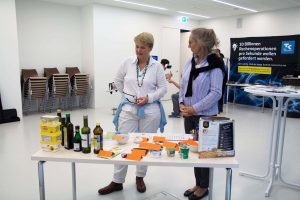
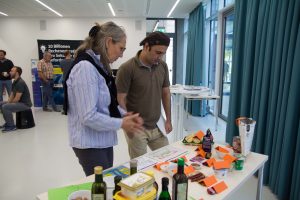
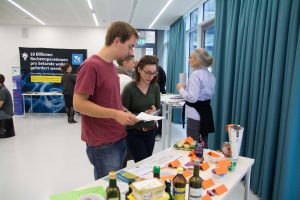
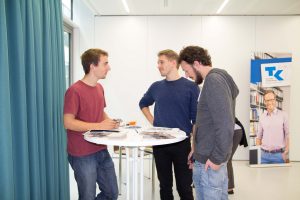
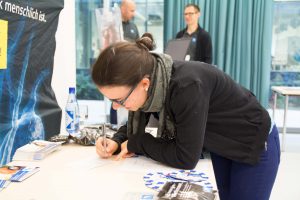
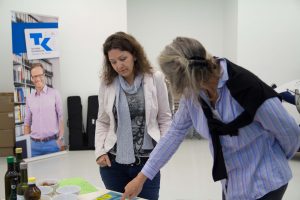
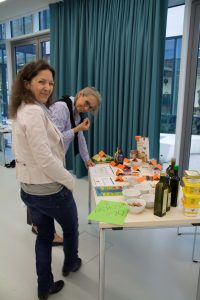
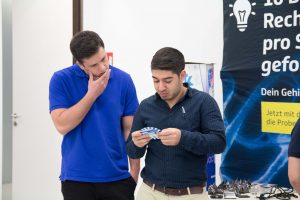
Sufficiently informed? With the ICAROS Flight Simulator, which was designed as a training device, you could test your own balance and deep muscles: The goal was to fly trough as many rings as possible in a simulated 3D mountain landscape. Last but not least, small table tennis tables offered space for a sporty workout.